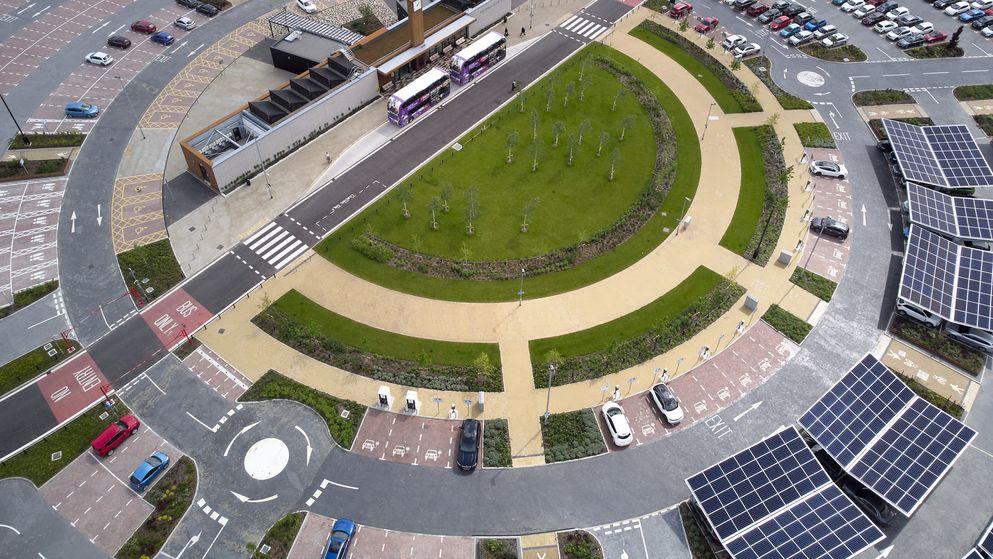
Maximising land use while minimising impact – why the built environment needs a ‘greenprint’ for a sustainable future
Maximising land use while minimising impact – why the built environment needs a ‘greenprint’ for a sustainable future
With fewer than 50 days to go until COP28, and following its President’s challenge to the private sector to step up, Dan Whiteley, Environmental Sustainability Director at leading construction and infrastructure business BAM UK & Ireland, looks at what this means for contractors in the built environment.
In the lead-up to COP28 President-Designate Dr Sultan Al-Jaber issued a rallying call to the private sector, highlighting the role it must play in supporting the objectives of the Paris Agreement.
The private sector in the UK makes up 5.5 million businesses1 and plays a crucial role in driving economic growth. The construction industry is responsible for 17% of that community2. Yet, buildings and construction also account for 39% of carbon emissions globally3 - so our industry has a dual responsibility both to drive economic development while also preventing climate change.
Our industry must recognise this duality and look beyond simply meeting targets. To realise a net zero and nature-positive future we have a role to play in driving forward change. How can contractors take on this mantle, and think differently to build a sustainable tomorrow?
Multi-purpose sites
One of the simplest and most effective ways to bolster sustainability is to maximise every single bit of development space so that our buildings and infrastructure deliver multiple uses and benefits. What if everything we built served not only its primary purpose but also a secondary purpose to benefit the environment?
Solar or photovoltaic (PV) panels present a scalable opportunity here. We have already witnessed an increased application of PV panels on homes, but the same approach for non-domestic buildings or structures, and even brownfield sites, could make a vast difference.
In France, sustainable energy infrastructure made substantial progress this year, with legislation being passed to mandate that car parks with over 80 spaces should install solar canopies. The move, which would see 50% of the car park’s area covered with PV panels, is projected to generate a mammoth 11GW of energy, equivalent to powering nearly 8 million homes.
Soon after, a CPRE and UCL Energy Institute report4 found that a huge opportunity lies in the UK’s existing car park infrastructure to make significant strides towards net zero. It found that were a similar initiative to be adopted in the UK, we could add capacity for an additional 11GW of clean, renewable energy to the National Grid.
Not only would this align with the nation's decarbonisation objectives, but it also strengthens future energy security at a time when geopolitics and economic headwinds have caused uncertainty for businesses and consumers alike. And it’s using existing infrastructure, too.
Contractors are likely already beginning to see requests for sustainable infrastructure development through dual or multi-use sites. At BAM, we built the UK’s first fully solar-powered park and ride at Stourton, as part of the £173.5 million Leeds Public Transport Investment Programme.
Boasting a number of sustainability credentials, the car park offsets 332 tonnes of carbon annually and removes 1,200 cars from roads during commuting hours. It operates an all-electric bus fleet, and a total of 30 customer electric vehicle (EV) charging points were also installed, provided with power generated by the solar panel canopies installed throughout the space.
Developers and contractors alike must consider how to harness the untapped potential of single-use space throughout the UK. Collectively, we must shift our thinking to allow this approach to become the standard, rather than the exception.

A holistic approach
However, making the most of land, whether through solar installations or green roofs, must be carefully balanced with protecting the biodiversity and natural resources around it. A holistic view must be taken when it comes to achieving sustainability.
Sustainable onsite and offsite processes will be a key consideration for contractors, including using local materials or suppliers to reduce transport-related emissions, embedding circularity, or investing in hydrogen-powered plant and machinery
However, too often, such sustainability initiatives exist in isolation. At BAM our sustainability strategy embraces the whole ecosystem and biodiversity is a key component, and one that is growing in importance, particularly when it comes to optimising land use.
Biodiversity provides essential ecosystem services such as pollination, water purification, and climate regulation. Not to mention, supporting native flora and fauna to thrive. By factoring in biodiversity in land use planning, contractors can reduce the reliance on costly and energy-intensive human interventions to replicate these services artificially; and can minimise our overall impact on the ecosystem.
Whether it’s the integration of green roofs and walls into urban environments, or the creation of ecological corridors for wildlife – such as the green bridge at our Cross Tay Link Road project in Perth, which includes the planting of 4,800 native trees – there are myriad tactics that contractors can use to ensure projects are in harmony with their natural environments. Biodiversity is a critical pillar of sustainable development. Almost half of Britain’s natural biodiversity has disappeared5 since the Industrial Revolution – the worst decline in Western Europe – and we cannot underestimate how this will impact economic growth, urbanisation and the built environment in the future.
During COP28, some 70,000 delegates including Heads of State and world leaders are expected to push forward on climate action across 198 countries. Despite its scale, we must heed the words of its President because our industry has a significant role to play. This responsibility goes beyond bricks and mortar: it extends to our commitment to sustainability and the environment. In doing so, we can not only drive economic growth but also contribute significantly to the global fight against climate change, leaving a legacy of sustainable development for generations to come.
The article first appeared in Construction News on 26 October 2023.

